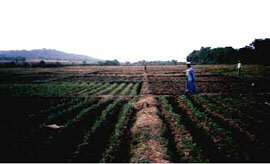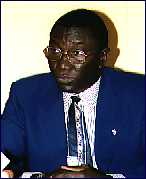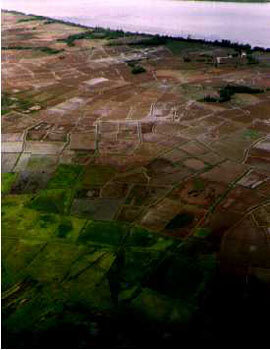 AGRICULTURE AGRICULTURE
 80% of THE POPULATION ARE PEASANTS 80% of THE POPULATION ARE PEASANTS

Agriculture, as opposed to mining, accounts for 18.6% of Guinea’s GNP and in 1996 meant 16% of export revenues. Yet 80% of the labor force are employed in this sector. After half a century of collectivism, peasants found no motivation to produce or invest, except in subsistence agriculture. In fact the sector is not still recovered from its past evils: 52% of the population living under poverty are peasants. Paradoxically this sector is potentially the largest generator of employment and revenues.
Modern enhanced cultivation methods are not available, stocking and transportation infrastructures are in an embryo stage, financing is still inadequate and an efficient commercialization circuit is needed. The ministry of agriculture - headed by Mr. Jean Paul Sarr - has set up a series of measures to improve present infrastructures, eradicate rural poverty, feed the population and become an agriculturally self-sufficient country.

 RURAL TRACKS COMMUNICATE ISOLATED PRODUCTION AREAS RURAL TRACKS COMMUNICATE ISOLATED PRODUCTION AREAS
The first step has been to develop rural infrastructures in order to communicate production areas. So far 7,000 Km of rural tracks have been constructed by Génie Rural, Guinea’s agricultural engineering institute, with help from USAID , World Bank and the Agence Française de Développement . This has reduced transportation costs and times by 50%, and has increased traffic by 60%. However, 60% of rural communities still remain without land communications
 PRIVATE INVESTMENT ENCOURAGED PRIVATE INVESTMENT ENCOURAGED
The second phase of agricultural policy has opened the door to private investors. The objective is to allow a faster passage from subsistence agriculture to cash crops. The first ones answering to Guinea’s call have been the Chinese and the Malays, who have heavily invested in the production of rice, Guinean’s staple food.
 RESEARCH INCREASES AGRICULTURAL PRODUCTION RESEARCH INCREASES AGRICULTURAL PRODUCTION
The liberalization of the rice market allowed local production to increase by 30% in one year. The goal for the year 2003 is to be totally self-sufficient in the production of this cereal. Agricultural production has also experienced a significant growth due to an increase of farmland areas, although forests and manglars have been destroyed in the process. But probably most important is the technological progress made thanks to the transfer of technology and agricultural research.
 RESEARCH: KEY TO A SUSTAINABLE AGRICULTURE RESEARCH: KEY TO A SUSTAINABLE AGRICULTURE
The Institut de Recherche Agronomique de Guinée (IRAG) is the organism responsible for agricultural research. IRAG’s main mission is to assure food availability for everyone in Guinea, especially through the increase of cereal production. Peasants are distributed high yield seeds or taught how to obtain better quality crops. Today rice harvest time has been reduced from 7 to 3 months, allowing 2-3 crops/year. This is probably IRAG’s most spectacular success. They have also successfully introduced clones for export crops such as coffee and pineapple. But despite international ONGs help, Mr. Sékou Cissée General Manager of IRAG, complains of their lack of financial support from developed countries.
|
 CHANGING THE SIGN OF THE AGRICULTURAL TRADE BALANCE CHANGING THE SIGN OF THE AGRICULTURAL TRADE BALANCE
Guinea’s agricultural balance is still negative, and even though it decreased from US$100 million in 1991 to less than US$50 million in 1994, Guinea has to import large quantities of food products - in 1996 imports of rice reached 231,652 tons. The government is determined to change the sign of the trade balance. Guinea’s high rainfall and varied climates make this country ideal for the cultivation of all kinds of cash crops adaptable for both inner consumption and export: rice, corn, coffee, cocoa, palm oil trees, exotic fruits (mangoes, pineapples, bananas, etc). It should be remembered that before independence Guinea produced 60% of the bananas of Western Africa. With help from international development agencies the production has considerably increased and consequently so have exports, doubling from 1992 to 1996.
 THE COTTON EXAMPLE THE COTTON EXAMPLE

Cotton production has been erratic in the past. From 1993 to 1995 cotton production decreased so dramatically the government set an emergency plan. In 1994 the Compagnie Française pour le Développement Textile (CFDT) was created to further develop this subsector. Peasants were encouraged to produce more cotton by slightly increasing its purchasing price. In 1997 production was 16,000 tons, a rise of 40% from previous year. By the end of 1998 production is expected to be 23,500 tons.
 RUBBER AND PALM OIL PRODUCTION: A SURE BET FOR THE FUTURE RUBBER AND PALM OIL PRODUCTION: A SURE BET FOR THE FUTURE
The Société Guinéenne de Palmier à l'Huile et d'Hévéas (Soguipah ) is the single largest producer palm oil trees, heveas and rubber. This is a curious case where a 100% state owned company is managed like a private company. Palm oil is mainly produced for local consumption, whereas rubber is grown for export. According to Soguipah higher officials, the rubber produced in Guinea has a better quality than that produced in South East Asia, and is the best in the sub-region. Their environmental policy is paying off. Former farmland has been planted with rubber and palm trees, creating forests in areas that were bound to become deserts.
 AGROINDUSTRY AGROINDUSTRY
According to Mr. J.-P.Sarr, minister of agriculture, 300,000 tons of mangoes are left to rot every year. Guinea desperately lacks the necessary industries to transform most of its agricultural products into added value goods. There are very few enterprises that have taken the step to process food products. Only Grands Moulins de Guinée, a flour mill determined to end up with French flour quasi-monopoly , and Salguidia, a 75% Libyan company owner of a tropical fruit juice processing plant for local consumption and export to West Africa. That is all. A few promising contacts have already been made during Conakry’s International Investors Forum, but in the meanwhile many more mangoes and other revenue making agricultural products will Continue rotting. |

